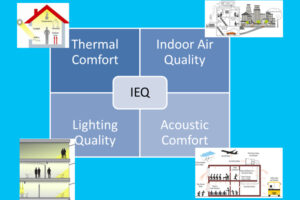Improving indoor air quality involve regular indoor air quality assessments.
Air quality risks in Indian office buildings Office buildings in India have several air quality risks resulting from interplay of inadequate ventilation, inadequate filtration, and poor source control.
- Inadequate ventilation
Carbon dioxide levels are often non-compliant in many buildings. The non-compliant spaces either have no outdoor air intake, or their outdoor air intake systems were non-operational, or, in some cases, the air handling units are so badly maintained that their choked filters did not allow sufficient outdoor air to enter indoors. Consequently, other indoor contaminants, such as formaldehyde and TVOC levels are also high in many buildings that are non-compliant with CO2.
- Inadequate filtration
Building preparedness to filter outdoor air pollutants is also lacking in India. Outdoor readings at the respective building locations show that particulate pollution is a major health risk in most Indian cities. Yet, many office buildings do not have filters for PM2.5 in their ventilation system; building systems equipped with filters often have gaps in maintenance that impact the filtration capacity.
Health impact of poor indoor air quality and inability of occupants to perceive the risks
A study of office buildings in India found that 45 percent of the people reported experiencing symptoms like eye irritation, fatigue, dizziness, and coughing; all of these are known to be associated with poor air quality. However, despite experiencing symptoms associated with poor indoor air quality, 68 percent of the people surveyed reported satisfaction with the indoor air in their offices. This shows that poor indoor air is not immediately perceptible, and occupants are unable to immediately associate it with the symptoms they might be experiencing, thus preventing any meaningful action on their part to ask for better indoor air.
- Avenues for improvement
A CO2 sensor based outdoor air intake control, with the sensor installed in the occupant breathing zone, is an effective strategy for maintaining sufficient outdoor air indoors. Real time monitoring of air quality using a combination of sensors covering both indoor and outdoor contaminants can provide adequate insights to building management teams and modulate the HVAC system to optimise indoor air quality. The avenues for improving indoor air quality involve regular indoor air quality assessments, appropriate filtration, configuring filtration and ventilation systems to reduce both indoor and outdoor pollutants.
In 2020, theCOVID-19 pandemic put the spotlight on poor indoor air quality and its possible role in the spread of the virus. ISHRAE and ASHRAE were quick to put out guidelines for safe operation of building systems. With the mounting evidence and pressure from the scientists, the World Health Organisation and Control also accepted transmission of the virus through aerosols.

In light of the pandemic, and the above mentioned understanding about the status of indoor air quality in office buildings in India, the following tools are now available for project teams to plan their safe re-entry into buildings and reduce air quality related risks for the future. They must be used in conjunction with the avenues for improvement listed above.
Tools for continuous improvement of air quality and safe re-entry into offices
As part of its Healthy Economy strategy – healthy people in healthy places equals a healthy economicus introduced the LEED Safety First pilot credits to help building teams provide healthy spaces, and to assist with re-entry. The pilot credits outline sustainable best practices that align with public health and industry guidelines related to cleaning and disinfecting, workplace re-occupancy, HVAC, and plumbing operations. The credits can be used by LEED projects that are certified or are undergoing certification.
In addition, Arc Re-entry provides tools to benchmark infection-control policies and procedures, collect occupant experiences, and track indoor air quality. It is available free for any project, anywhere to collect and manage disease control related information. Using the tool, project teams can generate a detailed re-entry report which provides insights to help the users determine where problems lie and how they can make improvements in their spaces. The Arc Re-entry guide is available for project teams to start planning their safe re-entry.
ISHRAE IEQ Standard, first launched in 2016, and now in its second iteration, is the first global standard that covers all aspects of indoor environmental quality. It classifies buildings as A (aspirational), B (Acceptable), and C (minimum acceptable) based on values of air quality, lighting, thermal, and acoustic parameters, and results of occupant perception surveys. It also elaborates on methods of measuring IEQ parameters. The standard can be used by organisations for single building or asset management of portfolio of buildings for improving the health and productivity of people in those spaces.
Cookie Consent
We use cookies to personalize your experience. By continuing to visit this website you agree to our Terms & Conditions, Privacy Policy and Cookie Policy.














